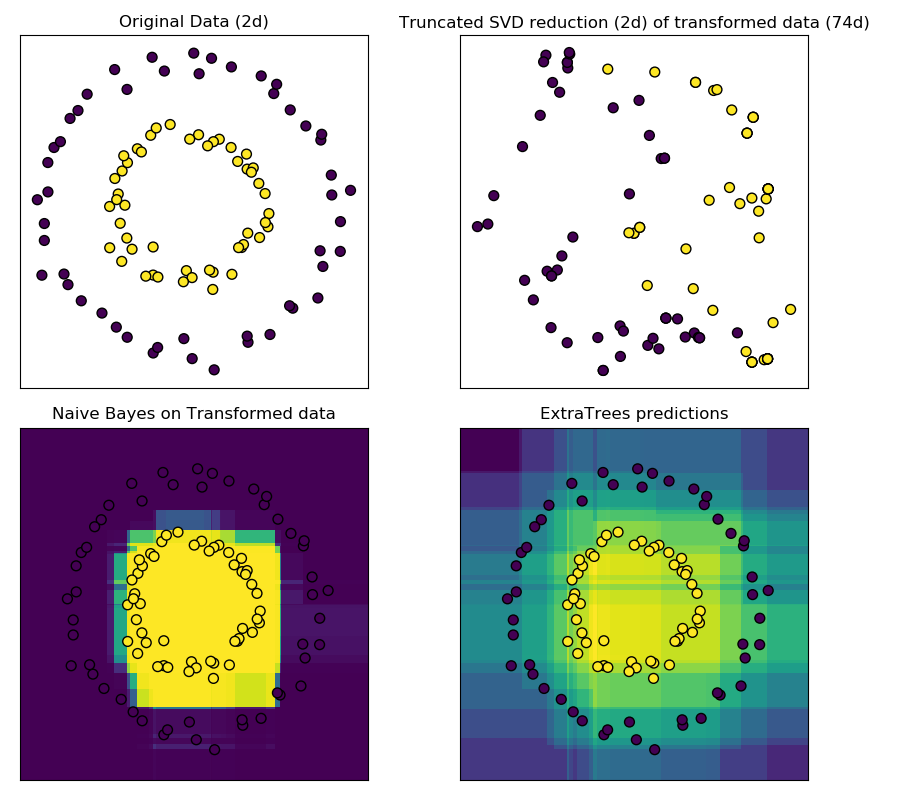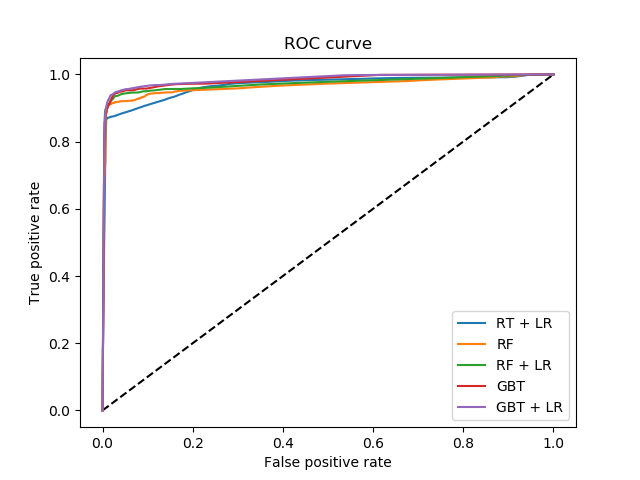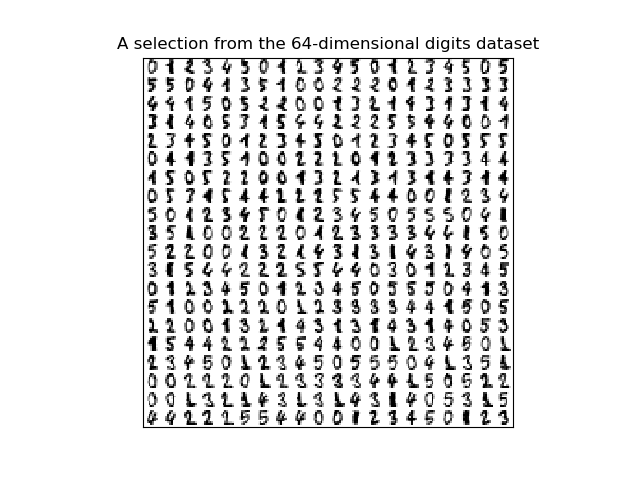sklearn.ensemble.RandomTreesEmbedding¶
class sklearn.ensemble.RandomTreesEmbedding(n_estimators=100, *, max_depth=5, min_samples_split=2, min_samples_leaf=1, min_weight_fraction_leaf=0.0, max_leaf_nodes=None, min_impurity_decrease=0.0, min_impurity_split=None, sparse_output=True, n_jobs=None, random_state=None, verbose=0, warm_start=False)
完全随机树的集成。
数据集到高维稀疏表示的无监督转换。数据点是根据它被分类到的每棵树的相应叶中来编码的。使用one-hot编码的叶子,这将导致二进制编码的数量与森林中的树一样多。
结果表示的维数为n_out <= n_estimators * max_leaf_nodes。如果max_leaf_nodes == None,则叶节点的数量最多为n_estimators * 2 ** max_depth。
在用户指南中阅读更多内容。
| 参数 | 说明 |
|---|---|
| n_estimators | int, default=100 森林中树木的数量。 在版本0.22中更改:默认值 n_estimators在0.22中从10更改为100。 |
| max_depth | int, default=None 树的最大深度。如果为None,则将节点展开,直到所有叶子都是纯净的,或者直到所有叶子都包含少于min_samples_split个样本。 |
| min_samples_split | int or float, default=2 分割一个内部节点所需的最小样本数: - 如果为int,则认为 min_samples_leaf是最小值。- 如果为float, min_samples_leaf则为分数, 是每个节点的最小样本数。ceil(min_samples_leaf * n_samples)在版本0.18中更改:添加了分数的浮点值。 |
| min_samples_leaf | int or float, default=1 一个叶节点上所需的最小样本数。只有当它在每个左右分支中都留下至少min_samples_leaf训练样本时,任何深度的分割点才会被考虑。这可能会产生平滑模型的效果,特别是在回归中。 - 如果为int,则认为 min_samples_leaf是最小值。- 如果为float, min_samples_leaf则为分数, 是每个节点的最小样本数。ceil(min_samples_leaf * n_samples)在版本0.18中更改:添加了分数的浮点值。 |
| min_weight_fraction_leaf | float, default=0.0 一个叶节点上所需的(所有输入样本的)总权重的最小加权分数。当不提供 sample_weight时,样本的权重相等。 |
| max_leaf_nodes | int, default=Nonemax_leaf_nodes以最好的方式进行“种树”。杂质的相对减少的节点被当作最佳节点。如果为None,则叶节点数不受限制。 |
| min_impurity_decrease | float, default=0.0 如果节点分裂会导致杂质的减少大于或等于该值,则该节点将被分裂。 加权减少杂质的方程式如下: N_t / N * (impurity - N_t_R / N_t * right_impurity - N_t_L / N_t * left_impurity)其中, N是样本总数,N_t是当前节点上N_t_L的样本数,是左子节点中的样本N_t_R数,是右子节点中的样本数。N,N_t,N_t_R并且N_t_L都指的是加权和,如果sample_weight获得通过。版本0.19中的新功能。 |
| min_impurity_split | float, default=None 树提升提前停止的阈值。如果节点的杂质高于阈值,则该节点将分裂,否则为叶。 - 从版本0.19 min_impurity_split开始不推荐使用:在版本0.19中不再推荐使用 min_impurity_decrease。的默认值 min_impurity_split在0.23中从1e-7更改为0,并将在0.25中删除。使用min_impurity_decrease代替。 |
| sparse_output | bool, default=False 是否返回稀疏CSR矩阵(默认行为),或返回与密集管道操作符兼容的密集数组。 |
| n_jobs | int, default=None 要并行运行的作业的数量。 fit, predict, decision_path 和 apply都在树中并行化。除非在一个joblib.parallel_backend的内容中,否则None在joblib中的表示是1。-1表示使用所有处理器。有关更多详细信息,请参见Glossary。 |
| random_state | int, RandomState, default=None 控制用于拟合树的随机 y的生成,以及绘制分割树节点上每个特征。有关更多详细信息,请参见Glossary。 |
| verbose | int, default=0 在拟合和预测时控制冗余程度。 |
| warm_start | bool, default=False 当设置为 True时,重用前面调用的解决方案来适应并向集成添加更多的评估器,否则,只会拟合完整的新森林。有关更多详细信息,请参见Glossary。 |
| 属性 | 说明 |
|---|---|
| estimators_ | list of DecisionTreeRegressor 拟合的子估计器的集合。 |
参考文献
P. Geurts, D. Ernst., and L. Wehenkel, “Extremely randomized trees”, Machine Learning, 63(1), 3-42, 2006.
Moosmann, F. and Triggs, B. and Jurie, F. “Fast discriminative visual codebooks using randomized clustering forests” NIPS 2007
实例
>>> from sklearn.ensemble import RandomTreesEmbedding
>>> X = [[0,0], [1,0], [0,1], [-1,0], [0,-1]]
>>> random_trees = RandomTreesEmbedding(
... n_estimators=5, random_state=0, max_depth=1).fit(X)
>>> X_sparse_embedding = random_trees.transform(X)
>>> X_sparse_embedding.toarray()
array([[0., 1., 1., 0., 1., 0., 0., 1., 1., 0.],
[0., 1., 1., 0., 1., 0., 0., 1., 1., 0.],
[0., 1., 0., 1., 0., 1., 0., 1., 0., 1.],
[1., 0., 1., 0., 1., 0., 1., 0., 1., 0.],
[0., 1., 1., 0., 1., 0., 0., 1., 1., 0.]])
方法
| 方法 | 说明 |
|---|---|
apply(X) |
将森林中的树应用于X,返回叶索引。 |
decision_path(X) |
返回森林的决策路径。 |
fit(X[, y, sample_weight]) |
拟合估计器。 |
fit_transform(X[, y, sample_weight]) |
拟合估计器和变换数据集。 |
get_params([deep]) |
获取这个估计器的参数。 |
set_params(**params) |
设置这个估计器的参数。 |
transform(X) |
转化数据集。 |
__init__(n_estimators=100, *, max_depth=5, min_samples_split=2, min_samples_leaf=1, min_weight_fraction_leaf=0.0, max_leaf_nodes=None, min_impurity_decrease=0.0, min_impurity_split=None, sparse_output=True, n_jobs=None, random_state=None, verbose=0, warm_start=False)
初始化self。有关准确的签名,请参见help(type(self))。
apply(X)
将森林中的树应用于X,返回叶子索引。
| 参数 | 说明 |
|---|---|
| X | {array-like, sparse matrix} of shape (n_samples, n_features) 输入样本。在内部,它的 dtype将被转换为dtype=np.float32。如果提供了一个稀疏矩阵,它将被转换为一个csr_matrix。 |
| 返回值 | 说明 |
|---|---|
| X_leaves | ndarray of shape (n_samples, n_estimators) 对于X中的每个数据点x和森林中的每棵树,返回x最终所在的叶子的索引。 |
decision_path(X)
返回森林中的决策路径。
版本0.18中的新功能。
| 参数 | 说明 |
|---|---|
| X | {array-like, sparse matrix} of shape (n_samples, n_features) 输入样本。在内部,它的 dtype将被转换为dtype=np.float32。如果提供了一个稀疏矩阵,它将被转换为一个csr_matrix。 |
| 返回值 | 说明 |
|---|---|
| indicator | sparse matrix of shape (n_samples, n_nodes) 返回一个节点指示符矩阵,其中非零元素表示样本经过节点。矩阵为CSR格式。 |
| n_nodes_ptr | ndarray of shape (n_estimators + 1,) 列元素来自指示符 [n_nodes_ptr[i]:n_nodes_ptr[i+1]]给出第i个估计器的指示值。 |
property feature_importances_
基于杂质的功能的重要性。
越高,功能越重要。特征的重要性计算为该特征带来的标准的(标准化)总缩减。这也被称为基尼重要性。
警告:基于杂质的特征重要性可能会误导高基数特征(许多唯一值)。另见 sklearn.inspection.permutation_importance。
| 返回值 | 说明 |
|---|---|
| feature_importances_ | ndarray of shape (n_features,) 除非所有树都是仅由根节点组成的单节点树,否则此数组的值总计为1,在这种情况下,它将是零数组。 |
fit(X, y, sample_weight = None)
拟合估计器。
| 参数 | 说明 |
|---|---|
| X | {array-like, sparse matrix} of shape (n_samples, n_features) 输入样本。在内部,它的 dtype将被转换为dtype=np.float32。如果提供了一个稀疏矩阵,它将被转换为一个csr_matrix。 |
| y | array-like of shape (n_samples,) or (n_samples, n_outputs) 目标值(分类中的类标签,回归中的实数)。 |
| sample_weight | array-like of shape (n_samples,), default=None 样本权重。如果没有,那么样本的权重相等。当在每个节点中搜索分割时,将忽略创建具有净零权值或负权值的子节点的分割。在分类的情况下,如果分割会导致任何一个类在任一子节点中具有负权值,那么分割也将被忽略。 |
| 返回值 | 说明 |
|---|---|
| self | object |
fit_transform(X, y=None, sample_weight=None)
拟合估计量和变换数据集。
| 参数 | 说明 |
|---|---|
| X | {array-like, sparse matrix} of shape (n_samples, n_features) 输入样本。在内部,它的 dtype将被转换为dtype=np.float32。如果提供了一个稀疏矩阵,它将被转换为一个csr_matrix。 |
| y | Ignored 未使用,按照约定呈现API一致性。 |
| sample_weight | array-like of shape (n_samples,), default=None 样本权重。如果没有,那么样本的权重相等。当在每个节点中搜索分割时,将忽略创建具有净零权值或负权值的子节点的分割。在分类的情况下,如果分割会导致任何一个类在任一子节点中具有负权值,那么分割也将被忽略。 |
| 返回值 | 说明 |
|---|---|
| X_transformed | sparse matrix of shape (n_samples, n_out) 转化后的数据集。 |
get_params(deep=True)
得到估计器的参数。
| 参数 | 说明 |
|---|---|
| deep | bool, default = True 如果为真,将返回此估计量的参数以及包含作为估计量的子对象。 |
| 返回值 | 说明 |
|---|---|
| params | mapping of string to any 名称参数及他们所映射的值。 |
set_params(**params)
设置该估计器的参数。
该方法适用于简单估计器和嵌套对象(如pipline)。后者具有形式为<component>_<parameter>的参数,这样就可以更新嵌套对象的每个组件。
| 参数 | 说明 |
|---|---|
| **params | dict 估计器参数 |
| 返回值 | 说明 |
|---|---|
| self | object 估计实例。 |
transform(X)
转化数据集。
| 参数 | 说明 |
|---|---|
| X | {array-like, sparse matrix} of shape (n_samples, n_features) 输入样本。在内部,它的 dtype将被转换为dtype=np.float32。如果提供了一个稀疏矩阵,它将被转换为一个csr_matrix。 |
| 返回值 | 说明 |
|---|---|
| X_transformed | sparse matrix of shape (n_samples, n_out) 转化后的数据集 |







